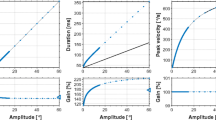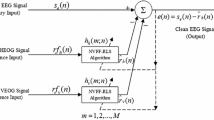Abstract
Influence of two filtering modes were researched with electro-oculographically recorded impulse-like eye movements. Linear finite impulse response (FIR) and nonlinear hybrid median filters were explored by considering gain and latency parameters that yield the most important information in the case of these eye movements. It is stated that carefully selected low pass filtering can securely be run without considerable change sin parameter values in order to discard noise stemming from physiological or other reasons.
Similar content being viewed by others
REFERENCES
Tabak S, Collewijn H, Boumans LJJM, van der Steen J. Gain and delay of human vestibulo-ocular reflexes to oscillation and steps of the head by a reactive torquet helmet. I. Normal subjects. Acta Otololaryngol 1997; 117: 785–795
Juhola M. A syntactic analysis method for eye movements of vestibulo-ocular reflex. Comput Meth Prog Biomed 1995; 46: 59–65
Juhola M, Pyykkoö I, Aalto H, Hirvonen T. Effects of digital filtering on the parameters of vestibulo-ocular reflex signals. Automedica 1998; 16: 205–216
Juhola M. Median filtering is appropriate to signals of saccadic eye movements. Comp Biol Med 1991; 21: 43–49
Juhola M. Effects of digital filtering on the parameters of sinusoidal tracking eye movements. Comp Biomed Res 1995; 28: 283–290
Aalto H, Juhola M, Pyykkoö I. A measurement system of head movements for the vestibulo-ocular reflex. Medical Progress through Technology 1993; 19: 153–157
Juhola M. A syntactic method for analysis of saccadic eye movements. Pattern Recognition 1986; 19: 353–359
Juhola M. A syntactic method for analysis of nystagmus and smooth pursuit eye movements. Comp Meth Prog Biomed 1988; 26: 53–62
Juhola M. A syntactic analysis method for sinusoidal tracking eye movements. Comp Biomed Res 1991; 24: 222–233
Juhola M, Aalto H, Hirvonen T. A signal analysis method for impulse-like eye movements. In: Kokol P, Zupan B, Stare J, Premik M, Engelbrecht R, eds., Proceedings of Medical Informatics Europe '99, Ljubljana, Slovenia, IOS Press, Studies in Health Technology and Information, 1999; 68: 365–368
Author information
Authors and Affiliations
Rights and permissions
About this article
Cite this article
Juhola, M., Aalto, H. & Hirvonen, T. Effects of Digital Filtering on the Parameters of Impulse-Like Eye Movements. J Clin Monit Comput 16, 287–294 (2000). https://doi.org/10.1023/A:1011408714679
Issue Date:
DOI: https://doi.org/10.1023/A:1011408714679




